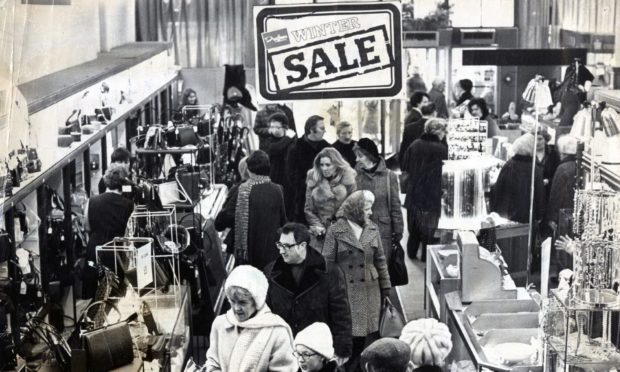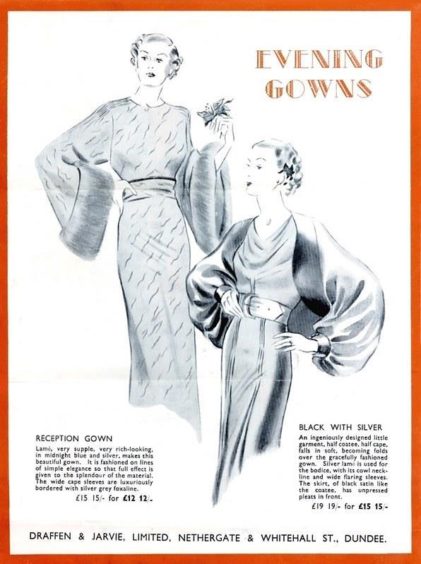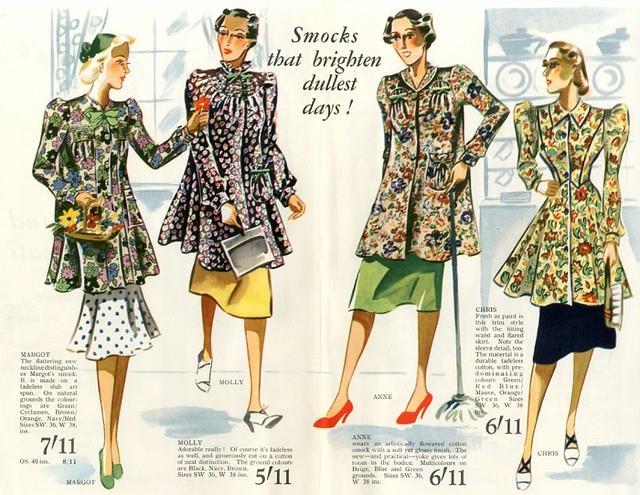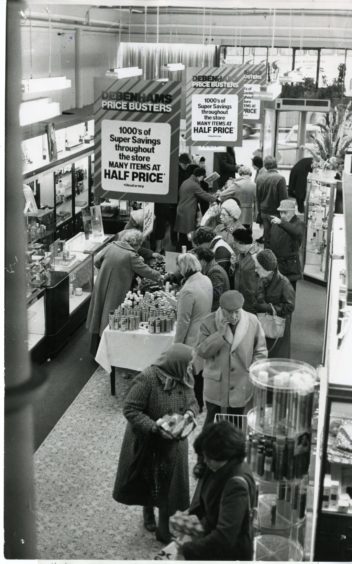Draffen’s was a landmark department store and stylish meeting place which numbered the late Queen Mother among its customers.
Local shoppers mourned the passing of the family firm when Debenhams took it over 40 years ago in March 1981.
The original firm began its career in 1834 when William Moon and John Langlands opened a little store at 10 Overgate.
Pioneering business
They were the pioneers of a new style of business and were the first shopkeepers in Dundee to deal in fixed prices, instead of selling, as the custom was then, by bargaining.
The new method met with an encouraging response from a time when gentlemen wore silks.
The quality of the goods attracted a growing custom and Moon and Langlands were soon on the hunt for bigger premises.
They moved to 27 Overgate and 1 Tally Street in 1837 and a circular was issued following the switch containing a list of goods for sale.
Men could choose their coats from cloths in blues, clarets, dahlias or olives; their vests from silk or swansdown; and trousers from cotton drills or painted moleskins.
The hosiery offered for sale for men included open-work silk stockings and by 1842 the new Overgate premises were too small for the ever-growing volume of customers.
Albion House was erected at the corner of Union Street and the firm stated that “each department will be found to contain a large assortment of very choice goods, and will be under the superintendence of a young man of experience who shall give the most vigilant attention to every customer”.
The original partnership came to an end a few years after the move to Union Street when Mr Langlands retired and was replaced by John Robertson.
The business flourished and prospered through the long rein of Queen Victoria until Mr Moon died in 1887 and the firm was bought by Thomas Blakeney.

Blakeney’s Building
A serious fire devastated Albion House and Mr Blakeney instigated a redevelopment of the centre of Dundee after the clearance of slum dwellings.
The firm moved into premises which were known as Blakeney’s Building at the corner of Whitehall Street and Nethergate.
In 1889 Mr Blakeney sold the concern to Coatbridge draper George Draffen, who ran the business in partnership with his brother-in-law John Jarvie.
In 1891, Mr Jarvie was bought out by Mr Draffen.
He was the sole proprietor until 1896 when he took his sons – William Stirling Draffen and John J Draffen – into partnership.
His sons played a leading part in the expansion of the business following his death and Draffen’s became increasingly well-known for its comprehensive service.
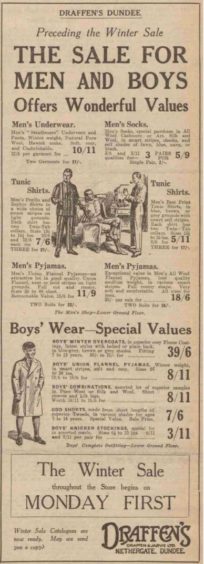
The firm celebrated its centenary in 1934 with the opening of a new men’s store and a series of displays and the exhibition ‘Cavalcade of Fashion – 1834-1833’.
Roy Langford, a costume scholar in London, arrived in Dundee to arrange the dresses for the exhibition which were coming from Canada.
A report in The Courier to mark the centenary said that some trouble had been caused ahead of the display “because the waists of ladies are not what they were”.
It read: “Many of the dresses are made for ladies with the famous ’18-inch waist’ and since ladies nowadays do not cultivate such a slender waist, Draffen’s have had to have 30 special busts made with the required measurements.
“One of the dresses which will be on view was actually worn by Queen Victoria, and all the dresses are beautiful specimens which will arouse great interest.
“Concurrently, with the Cavalcade, there will be held a parade of modern fashions and exhibitions of needlework, beauty preparations and rugmaking.”
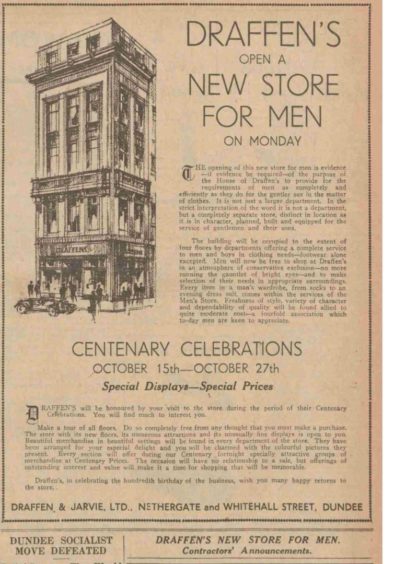
White handkerchief
The department store had a prominent impact on Dundee’s shopping and social scene and gradually introduced various tearooms, lounges and a restaurant on its top floor.
The firm continued to be known as Draffen and Jarvie Ltd before becoming Draffen’s of Dundee in 1948.
The manager would dust down the banister with his white handkerchief prior to opening to check that it came up to the high standards set by the family firm.
Before the age of the internet there was electronic online ordering available for the well-heeled – you could simply order by telegram, and the 1950 street directory showed Draffen’s telegraphic address as ‘Draffen’.
Rival D.M Brown had to be content with ‘Animated’.
This was all during the halcyon days of Dundee’s ‘big four’ department stores – G.L Wilson, Draffen’s, D.M Brown and Smith Brothers.
They set the bar and all went from humble, hard-grafting beginnings to become lavish department stores that would have graced the most affluent areas of London.
These were the jewels in the crown of Dundee’s retailing trade for decades, at a time before the High Street chains which now dominate had arrived in the city.
Slow decline
Draffen’s was turned into a public company and in 1960 almost all the shares were sold to Blyths Ltd, an Edinburgh firm, itself a member of the James Grant and Co (East) Ltd group.
The store and its associated restaurant went into a slow decline before being taken over by Debenhams in March 1981.
Debenhams then spent almost two decades at the site before it became the anchor store at the heart of the Overgate’s second reincarnation in Dundee in March 2000.
In 2016 part of the basement area was reopened to form a speakeasy bar, which has continued the Draffen’s name, and in December 2019 the green light was given to plans for even more of the old department store’s floors to be opened up and turned into a whisky bar and Asian-style restaurant.
